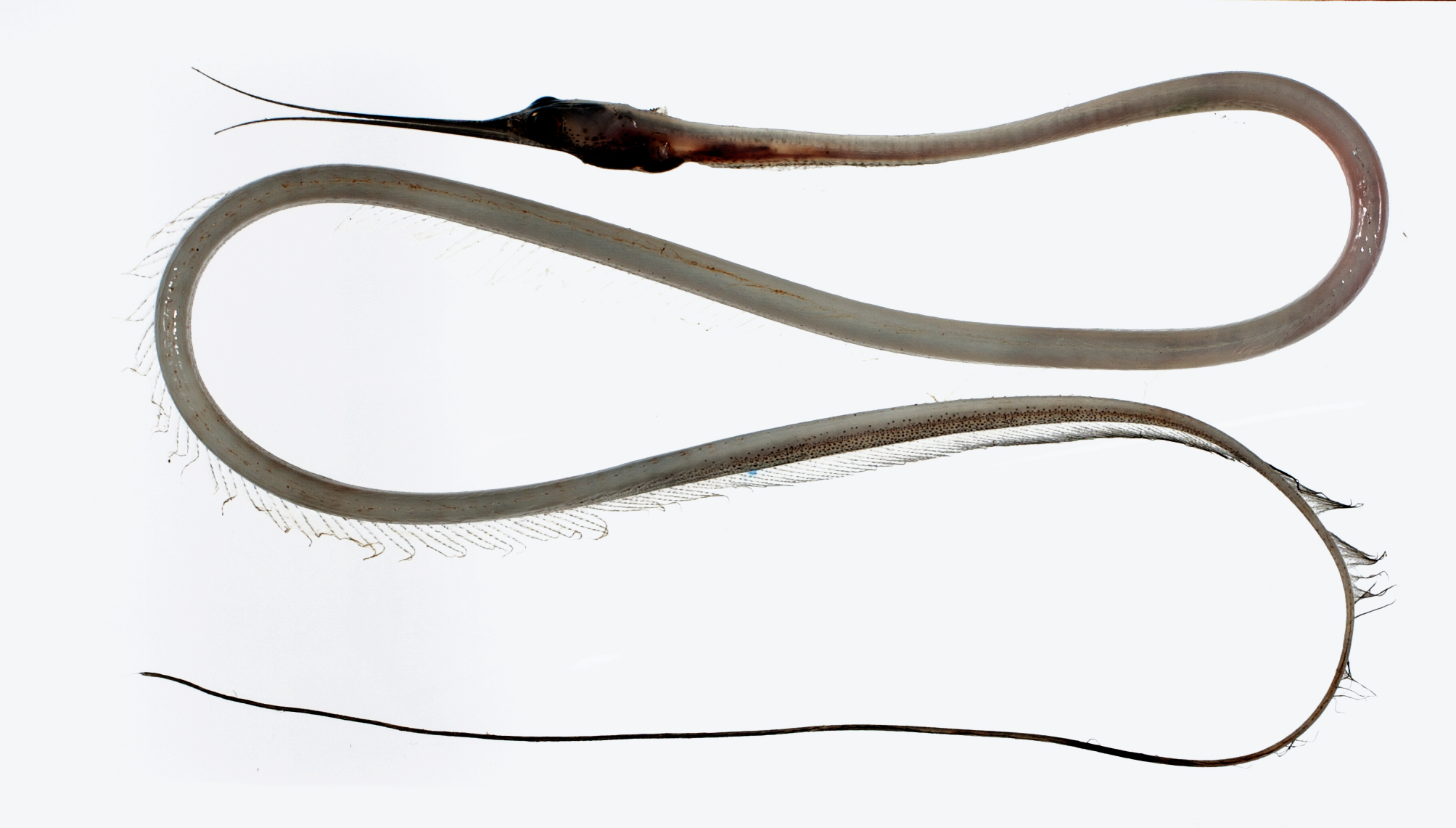Slender Snipe Eel, Nemichthys scolopaceus Richardson 1848
Other Names: Slender Snipe-eel, Snipe Eel, Threadeel, Threadfish

A Slender Snipe Eel, Nemichthys scolopaceus, from the Norfolk Ridge, May 2003. Source: NORFANZ Founding Parties. License: CC by Attribution-NonCommercial-ShareAlike
Summary:
A very long, slender dark brown to greyish eel, often darker below, with the anal fin and pectoral-fin tips black, long outwardly curved jaws (in females and juveniles), and large eyes. The dorsal fin commences above or slightly before the pectoral-fin base, and the anus is below the pectoral-fin base.
Spectacular footage of a snipe eel swimming near the bottom.
Spectacular footage of a snipe eel swimming near the bottom.
Cite this page as:
Bray, D.J. 2022, Nemichthys scolopaceus in Fishes of Australia, accessed 25 Apr 2024, https://fishesofaustralia.net.au/home/species/3434
Slender Snipe Eel, Nemichthys scolopaceus Richardson 1848
More Info
|
Distribution |
South of Robe, South Australia, to north of Bathurst Island, Northern Territory, and the Coral Sea NE of Cairns, Queensland, to the southern Tasman Sea, Tasmania; also the Christmas Island area in the eastern Indian Ocean, and the Lord Howe Rise and Norfolk Ridge in the Tasman Sea. Elsewhere the species is circumglobal in tropical and temperate latitudes. Inhabits mesopelagic to bathypelagic depths. |
|
Features |
Postorbital pores 6-17, arranged in a staggered row; Preopercular pores 6-13. Body extremely long, even filamentous, delicate; pectoral fins present; dermal ridges absent. Jaws greatly produced forwards, and typically curving apart, but greatly shortened in mature males. Teeth, minute, in many rows, forming rasp-like surfaces on jaws and vomer. Dorsal-fin origin slightly before or over pectoral-fin base; anus far forwards, under pectoral base; median fins continuous around tail. |
|
Feeding |
Feeds mostly on crustaceans, especially decapods and euphausids. Snipe eels have minute backward-pointing teeth that prevent their crustacean prey from escaping. |
|
Remarks |
The jaws of males become shorter as they grow, and they also lose their teeth. |
|
Etymology |
The species is named scolopaceus in reference to the similarity between the snipe eel jaws to the long bird beak of birds belonging to Scolopax, a genus of long-billed wading birds. |
|
Species Citation |
Nemichthys scolopacea Richardson 1848, in Adams, Zool. Voy. of H.M.S. Samarang: 25, Pl.10 (figs.1-3). Type locality: South Atlantic off Brazil. |
|
Author |
Bray, D.J. 2022 |
|
Resources |
Slender Snipe Eel, Nemichthys scolopaceus Richardson 1848
References
Castle, P.H.J. 1986. Family No. 51: Nemichthyidae. pp. 193-194 in Smith, M.M. & Heemstra, P.C. (eds). Smith's Sea Fishes. Johannesburg : Macmillan South Africa xx + 1047 pp. 144 pls.
Feagans-Bartow, J.N. & Sutton, T.T. 2014. Ecology of the oceanic rim: pelagic eels as key ecosystem components. Marine Ecology Progress Series 502: 257-266. https://doi.org/10.3354/meps10707
Flynn, A.J. & Pogonoski, J.J. 2012. Guide to Mesopelagic Fishes of the Southern Tasman Sea. Hobart, Australia : CSIRO Marine and Atmospheric Research i-v + 221 pp.
Karmovskaya, E.S. 1990. Leptocephali of eels of the genus Nemichthys (Nemichthyidae, Osteichthys). Journal of Ichthyology 30(4): 28-42 [original in Voprosy ikhtiologii 30:(4): 551-563, in Russian]
Karmovskaya, E., Papaconstantinou, C., de Morais, L., Smith-Vaniz, W.F., Carpenter, K.E. & de Bruyne, G. 2015. Nemichthys scolopaceus. The IUCN Red List of Threatened Species 2015: e.T190214A60794470. http://dx.doi.org/10.2305/IUCN.UK.2015-4.RLTS.T190214A60794470.en. Downloaded on 10 June 2017.
Richardson, J. 1848. Fishes. 1-28 pls 1-10 in Adams, A. (ed.) The Zoology of the Voyage of H.M.S. Samarang under the Command of Captain Sir Edward Belcher during the years 1843–1846. London : Reeve, Benham & Reeve.
Smith, D.G. 1999. Families Colocongridae, Derichthyidae, Muraenesocidae, Nemichtyhyidae, Congridae, Nettastomatidae, Serrivomeridae, Cyematidae, Saccopharyngidae, Eurypharyngidae, Monognathidae. pp. 1670-1697 in Carpenter, K.E. & Niem, V.H. (eds). The Living Marine Resources of the Western Central Pacific. FAO Species Identification Guide for Fisheries Purposes. Rome : FAO Vol. 3 pp. 1397-2068.
Smith, D.G. 2008. Family Nemichthyidae. pp. 170-173 in Gomon, M.F., Bray, D.J. & Kuiter, R.H. (eds). Fishes of Australia's Southern Coast. Sydney : Reed New Holland 928 pp.
Smith, D.G. & Nielsen, J.G. 1989. Family Nemichthyidae pp. 441–459 in Böhlke, E.B. (ed.) Orders Anguilliformes and Saccopharyngiformes. Fishes of the Western North Atlantic. Sears Found. Mar. Res., Yale Univ., Part 9. 1-6555 pp.
Richardson, J. 1848. Fishes. 1-28 pls 1-10 in Adams, A. (ed.) The Zoology of the Voyage of H.M.S. Samarang under the Command of Captain Sir Edward Belcher during the years 1843–1846. London : Reeve, Benham & Reeve.
Smith, D.G. & Stewart, A.L. 2015. Families Derichthyidae, Nemichthyidae, Congridae, Nettastomatidae, Serrivomeridae. pp. 259-290 in Roberts, C.D., Stewart, A.L. & Struthers, C.D. The Fishes of New Zealand. Wellington : Te Papa Press Vol. 2 pp. 1-576.
Sutton, T.T., Hulley, P.A., Wienerroither, R., Zaera-Perez, D. & Paxton, J.R. 2020. Identification guide to the mesopelagic fishes of the Central and South East Atlantic Ocean. Food and Agriculture Organization of the United Nations, Rome: i-xvi + 1-327.




